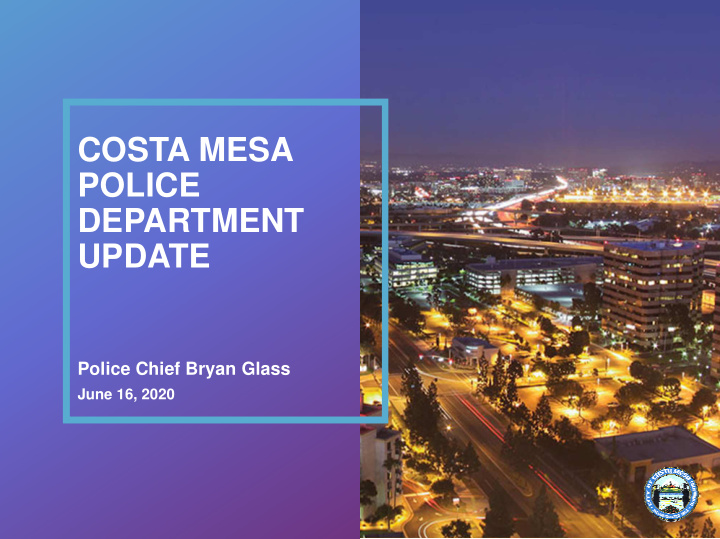



COSTA MESA POLICE DEPARTMENT UPDATE Police Chief Bryan Glass June 16, 2020
CMPD UPDATE Hiring Focus on: 1. Quality 2. Character 3. Responsible Behavior 4. Diversity 5. Reflective of the Community
CMPD UPDATE Training 1. Police Officer Standards & Training (POST) 2. Academy • Cultural Diversity/Discrimination • Principled Policing • Use of Force/De-escalation 3. Department • Field Training Program • Quarterly Firearms • Bi-monthly Briefing • Lexipol Daily Training Bulletins • Unconscious Bias 4. Advanced Officer & Perishable Skills • Tactical Communications • Bias & Racial Profiling (prevention) • Arrest Control Techniques (ACT) • Ethics • Crisis Intervention Training 1, 2, 3
CMPD UPDATE Policy 1. Ban Chokeholds & Strangleholds – Yes Chokeholds and strangleholds are not taught, used, or authorized by the department. The carotid restraint control hold was permitted by trained officers in situations involving violence or physically combative individuals (300.3.4). However, the department suspended the use of this technique as a compliance tool pending further evaluation of its use and effectiveness. 2. Require De-escalation Training – Yes De-escalation is interwoven into the department’s operations through training and is specifically included in our Taser (304.4) and crisis intervention (409.6) policies. De-escalation techniques are included in various advanced officer training courses and mandated in our arrest and control training sessions. This training is renewed every two years and has been the focus of the tactical communication and crisis intervention training we proactively send officers to attend.
CMPD UPDATE Policy Continued 3. Require Warning Before Shooting – Yes Verbal warnings prior to discharging a firearm at an individual is part of our policy, training curriculum, and practices related to the application of deadly force (300.4), control devices and techniques (303.9.2), and Taser (304.4). Officers are trained to communicate and de-escalate incidents to gain compliance before firing their firearm in an effort to resolve situations peacefully. 4. Exhaust all Alternatives Before Shooting – No Department policy requires officers to evaluate the use of other reasonably available resources and techniques when determining whether to use deadly force (300.3 & 300.3.2). This includes de-escalation through tactical communications, less lethal options, and to the application of deadly force when there is an imminent threat of death or serious injury to the officer or another person (300.4).
CMPD UPDATE Policy Continued 5. Duty to Intervene – Yes Officers have the duty to intervene, in accordance with our policy (300.2.1), when they observe the application of force by another officer that is not reasonable. 6. Ban Shooting at Moving Vehicles – Partially Shooting at a moving vehicle is limited only to incidents where officers believe there are no other reasonable means available to avert the threat of the vehicle, or if deadly force other than the vehicle is directed at the officer or others (300.4.1). 7. Require a Use of Force Continuum – No The department’s use of force policy (300.3) provides that an officer may use objectively reasonable force to overcome resistance, prevent escape, or effect an arrest (300.3.1) and outlines a list of considerations when deciding what level is to be used based on the facts and totality of the circumstances presented (300.3.2).
CMPD UPDATE Policy Continued 8. Require Comprehensive Reporting – Yes Comprehensive reporting and documentation of the use of force is required throughout all levels of the organization through department policies (300.5, 300.5.1, & 300.5.2). Further, all reported incidents are reviewed and evaluated by the department’s Professional Standards Bureau (Internal Affairs) for policy compliance and oversight.
CMPD UPDATE Use of Force Three-year summary: Calls for Service Arrests Use of Force Complaints 2017 113,738 6,137 45 2 2018 113,512 6,667 56 1 2019 115,415 6,619 48 1
CMPD UPDATE Actionable Next Steps 1. Implementation of Body Worn Cameras (BWCs) 2. Evaluation and potential implementation of software to enhance the review and oversight of all use of force incidents, pursuits, citizen and administrative complaints, and on-duty traffic accidents 3. Evaluation of use of force reporting requirements
Recommend
More recommend